  Fossils are the preserved remains of animals and plants whose bodies were buried in sediments, such as sand and mud, under ancient seas, lakes and rivers. Fossils can include any preserved trace of life that is typically more than 10,000 years old. 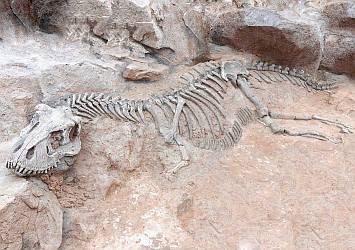 Soft body parts, such as skin, eyes and internal organs, decay soon after death, and are seldom fossilized. The hard parts, however, such as bones, claws, shells and teeth, last long enough to be replaced by minerals that harden, over thousands of years, into rock.
Soft body parts, such as skin, eyes and internal organs, decay soon after death, and are seldom fossilized. The hard parts, however, such as bones, claws, shells and teeth, last long enough to be replaced by minerals that harden, over thousands of years, into rock. In exceptional cases, some soft parts like feathers, leaves, footprints or dung, may also be preserved. Remains can even be microscopically small, such as single-celled pollen grains. Fossils provide evidence for the evolution of living organisms, as well as the adaptation of plants and animals to their environments. Fossil evidence provides a record of how creatures evolved, and how this process can be represented by a ‘tree of life’, showing that all species are related to each other. Fossils can also be used to date rocks. Different kinds of fossils occur in rocks of different ages, enabling geologists to use fossils to understand geological history. Ammonites, for example, can be used to determine the relative age of two or more layers of rock, or strata, that are in different places. Fossils are typically found in sedimentary rocks, and occasionally some metamorphic rocks. Sometimes the fossils have worn away, leaving moulds in the surrounding rock, which may have later been filled by other materials, forming casts of the original fossils. Rapid burial by sediments that were suspended in water is required for fossilisation to occur. The burial process protects the remains from the biological and physical processes that would otherwise break up or dissolve the body material. Fossils are more likely to have been preserved where there were ancient lakes, rivers or oceans, where rapid burial by sediments was possible. There are four ways that fossils are preserved:
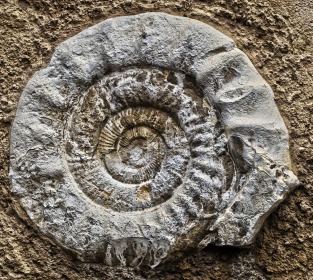 This is the most common method of fossilisation. After a shell, bone or tooth is buried in sediment, it can be exposed to mineral-rich fluids moving through the porous rock, such as calcium carbonate or silica. Eventually, the minerals entirely replace the organic material, and the remains are literally turned into stone, or ‘petrified’.
This is the most common method of fossilisation. After a shell, bone or tooth is buried in sediment, it can be exposed to mineral-rich fluids moving through the porous rock, such as calcium carbonate or silica. Eventually, the minerals entirely replace the organic material, and the remains are literally turned into stone, or ‘petrified’. Petrified fossils form when minerals replace the structure of an organism. This process, called permineralization, occurs when groundwater solutions saturate the remains of buried plants or animals. As the water evaporates the minerals remain, eventually filling in the spaces left as the organism slowly decays. See an example of fossilized dinosaur skin, and the largest snake that ever lived, the Titanoboa. 2. Compression 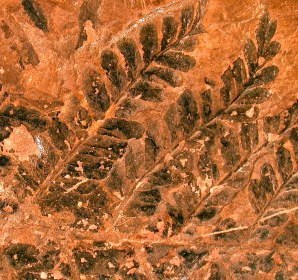 Some fossils form when their remains are compressed. A two-dimensional imprint of the fossil is produced as a result of high-pressure forces exerted by the weight of overlying sediments and perhaps sea water.
Some fossils form when their remains are compressed. A two-dimensional imprint of the fossil is produced as a result of high-pressure forces exerted by the weight of overlying sediments and perhaps sea water.Compression mainly occurs with plants, retaining some of the original organic matter, although usually altered in the form of coalification (a geological process that forms materials with an increasing proportion of carbon from the organic materials, that will eventually result in a gradual transformation into coal). 3. Moulds and Casts 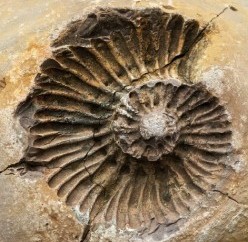 In cases where the original shell or bone is dissolved away, it may leave behind a space in the shape of the original object, called a mould. These can be very detailed. At some point after that, sediments may fill the space inside the mould, to form a matching cast.
In cases where the original shell or bone is dissolved away, it may leave behind a space in the shape of the original object, called a mould. These can be very detailed. At some point after that, sediments may fill the space inside the mould, to form a matching cast. Soft-bodied sea creatures such as snails are most commonly found as moulds and casts because their shells dissolve easily. A cast is a positive impression of the original material, created by sediments filling the mould and eventually hardening. 4. Preserved Remains 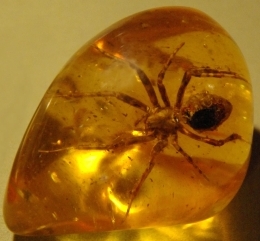 The rarest form of fossilisation is the preservation of original skeletons including soft body parts. Insects that have been trapped and preserved perfectly in amber (fossilised tree resin) are examples of preserved remains. Frozen mammals such as mammoths released by melting permafrost in the arctic are also examples.
The rarest form of fossilisation is the preservation of original skeletons including soft body parts. Insects that have been trapped and preserved perfectly in amber (fossilised tree resin) are examples of preserved remains. Frozen mammals such as mammoths released by melting permafrost in the arctic are also examples. Unaltered fossil remains are comprised of the original materials, including tissues, produced by an organism when it was alive. These materials have not changed into something else over geological time. It is worth pointing out that DNA is a very fragile molecule. Strands of DNA have in fact been recovered from preserved remains of mammals and proto-humans, some as old as several hundred thousand years. Dinosaur DNA, however, being tens of millions of years old and fossilized through petrification, is unlikely to have survived intact. Dating Fossils Dating methods give estimates of the age of certain geological materials associated with fossils, and even direct age measurements of the fossil material itself. To establish the age of a rock or a fossil, researchers use some type of 'clock' to determine the date it was formed. Geologists commonly use radiometric dating methods, based on the natural radioactive decay of certain elements such as potassium and carbon, as reliable clocks to date ancient events. For example, fossilized organic material that is less than 40,000 years old can be reliably dated using carbon-14 decay. Geologists can also use other methods to determine the age of rocks or fossils, as listed in the table below. All of these are based on the radioactive decay of various isotopes, a physics process which is very well understood. 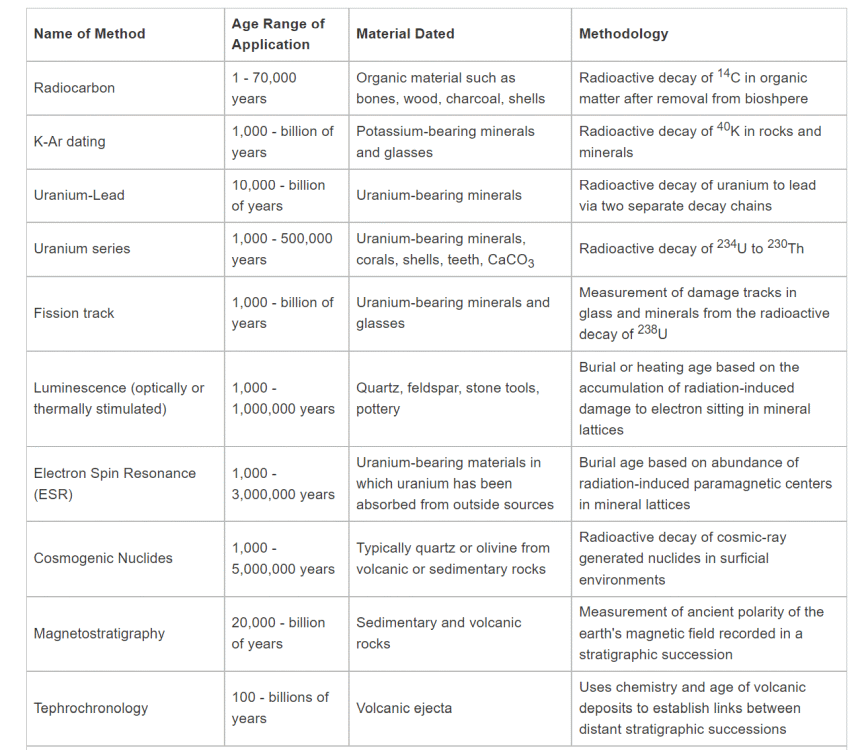 Table credit:
The Nature Education Knowledge Project
Fascinating Examples of Fossils Coprolites 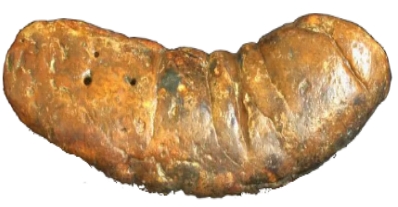 Coprolites are fossilized dinosaur feces, first discovered during the early 20th century. These help scientists to find out what type of food extinct dinosaurs ate.
Coprolites are fossilized dinosaur feces, first discovered during the early 20th century. These help scientists to find out what type of food extinct dinosaurs ate. For example, in Australia these coprolites revealed that plesiosaurs that lived during the Cretaceous period were bottom feeders. Hadrosaurus 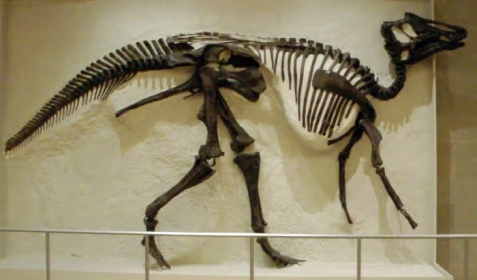 This Hadrosaurus is a species of duck-billed dinosaur that lived in the forests and freshwater regions of North America.
This Hadrosaurus is a species of duck-billed dinosaur that lived in the forests and freshwater regions of North America. The fossil pictured here after excavation was considered the first ever nearly complete dinosaur fossil found in the United States, and probably the most complete one to be discovered anywhere in the world. Baby Mammoth  A baby woolly mammoth, an example of a 'preserved remains' fossil, was discovered in the Yukon. It likely died in a storm more than 30,000 years ago.
A baby woolly mammoth, an example of a 'preserved remains' fossil, was discovered in the Yukon. It likely died in a storm more than 30,000 years ago. This is the first near-complete baby woolly mammoth found in North America; it was found by a miner in the Yukon's gold fields. It is believed that in order for her to be so well-preserved, a storm likely buried her, shielding her from the elements and other animals. Diplodocus 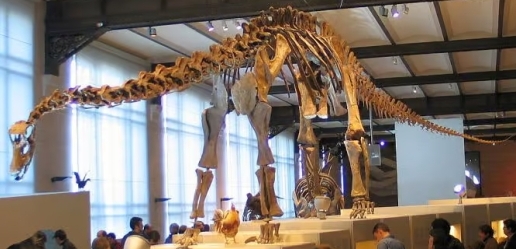 Aside from being known as the longest dinosaur, the Diplodocus is also famous for its unique body construction, having two rows of bones under its tail for additional support.
Aside from being known as the longest dinosaur, the Diplodocus is also famous for its unique body construction, having two rows of bones under its tail for additional support.Among all the fossils of Diplodocus unearthed, the one pictured here was the longest, with a length of 33 meters. Combat 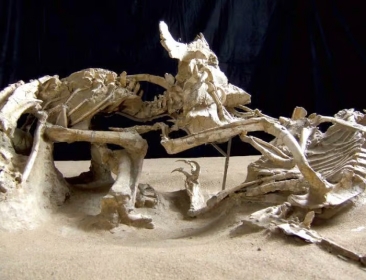 An amazing fossil discovery was a fossilized 'combat‘ between a carnivorous Velociraptor and an herbivorous Protoceratops.
In the fossil, the Protoceratops was hit at its carotid artery by the Velociraptor’s claw. The Protoceratops fought back and locked its jaws on the arms of the Velociraptor. Scientists believe that while these dinosaurs were fighting for their lives, a large land mass, possibly a sand dune, suddenly collapsed on them.
An amazing fossil discovery was a fossilized 'combat‘ between a carnivorous Velociraptor and an herbivorous Protoceratops.
In the fossil, the Protoceratops was hit at its carotid artery by the Velociraptor’s claw. The Protoceratops fought back and locked its jaws on the arms of the Velociraptor. Scientists believe that while these dinosaurs were fighting for their lives, a large land mass, possibly a sand dune, suddenly collapsed on them.This fossilized combat between the two dinosaurs was unearthed in the Gobi desert in Mongolia, in 1971. Plesiosaurs 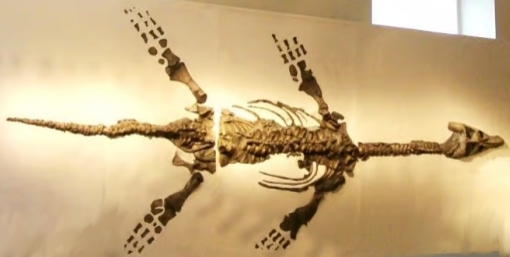 Plesiosaurs were carnivorous dinosaurs, apex predators, that swam in prehistoric oceans. The pictured plesiosaur fossil was discovered in 1994. The fossil was still intact, and the whole body was completely preserved, making it one of the oldest and most complete fossils ever discovered.
Plesiosaurs were carnivorous dinosaurs, apex predators, that swam in prehistoric oceans. The pictured plesiosaur fossil was discovered in 1994. The fossil was still intact, and the whole body was completely preserved, making it one of the oldest and most complete fossils ever discovered. It was discovered in a 60 metre deep mine in Alberta. Dinosaur Nest 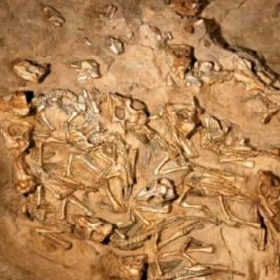 In 2011 in Mongolia, a paleontologist unearthed a nest containing the remains of 15 baby dinosaurs of the species Protoceratops andrewsi. Once again it is hypothesized that sand dunes might have overrun this nest during a storm, burying them all alive.
In 2011 in Mongolia, a paleontologist unearthed a nest containing the remains of 15 baby dinosaurs of the species Protoceratops andrewsi. Once again it is hypothesized that sand dunes might have overrun this nest during a storm, burying them all alive.This discovery of the nest provides the first evidence that young dinosaurs of this species stay in nests for an extended period. Analyses revealed that all 15 dinosaurs were relatively the same size and at the same period of physical and sexual maturity, suggesting that they were infants from the same mother. Humanoid Footprints 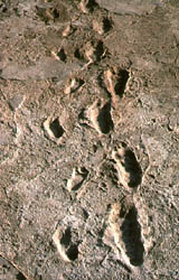 How do we know if an early humanoid walked upright? An examination of certain bones - a tibia (leg bone) or a pelvis, for example - can reveal the answer. So can fossilized footprints.
How do we know if an early humanoid walked upright? An examination of certain bones - a tibia (leg bone) or a pelvis, for example - can reveal the answer. So can fossilized footprints.In 1976, members of a team led by Mary Leakey discovered the fossilized footprints of human ancestors in Laetoli, Africa. The footprints were formed 3.5 million years ago when at least two individuals walked over wet volcanic ash. The wet ash hardened like cement and was then covered by more ash. The footprints show that the individuals had perfect, two-footed strides. They also reveal that one hominid was larger than the other. Because the footprints fall next to each other, they indicate that the two hominids were walking side by side and close enough to each other to be touching. Dinosaur Footprints 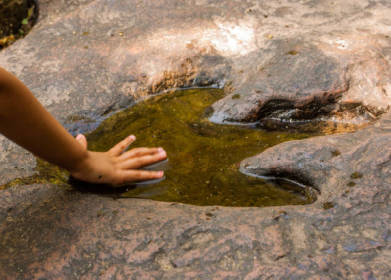 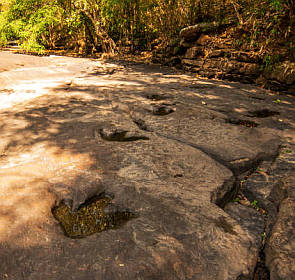 Preserved footprints, also known as ichnites, are a type of trace fossil and a glimpse into the lives of dinosaurs. They formed in the same way our footprints do when walking on soft ground like mud. But rather than being washed away, evidence of some of these reptiles' movements has survived for millions of years. Ancient shorelines and mudflats are common locations to find preserved dinosaur tracks. For tracks to form and preserve, conditions must be just right. Unlike bones, which needed to be covered quickly once a dinosaur died to preserve as much of the animal as possible, tracks first needed to be baked hard by the Sun. This would have taken anywhere from days to months, depending on the conditions. Only then would a layer of mud, ash or similar material help to preserve the tracks. |